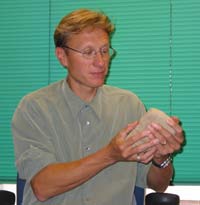A new focus for environmental activism? Here’s the dirt . . .
Researchers find pristine soils losing out to farming and development
![]()
| 01 October 2003
| |  Professor Ronald Amundson examines an aggregate from the naturally salty Fresno soil series. These soils took 10,000 years to form, and more than half of this soil type has been converted to farmland. Kathryn Stelljes photo |
A new study by Berkeley researchers may lead some people to rethink the phrase “common as dirt.” A paper published in the journal Ecosystems finds that certain soils — like certain plants and animals — are becoming increasingly rare, with some effectively extinct or at imminent risk of becoming so.
In some agricultural regions, up to 80 percent of soils considered rare have been reduced to less than half of their original extent. That is, more than half of the soil has been converted to agriculture or urban uses.
“Over the past two centuries, we have reconfigured part of a continent to the point where today’s landscape is almost unrecognizable” compared to its natural state, said Ronald Amundson, professor of ecosystem sciences in the College of Natural Resources and lead author of the paper. “The Great Plains used to be characterized by tall grasses and prairies. They have now been replaced by crops and housing tracts.”
Like plants and animals, soils have their own taxonomy. In the United States, 11 soil orders are ultimately divided into 13,129 series. (A soil series is comparable to a plant or animal species.) Soils that comprise less than 25,000 acres are considered rare; “rare-unique” soils are similarly limited in acreage, and in addition exist within the boundaries of a single state.
The researchers, who considered a rare or rare-unique soil endangered if more than half of its area was tilled, excavated, or otherwise disturbed, found 508 endangered soil series in the United States. Six states have more than half of their rare soil series in an endangered condition, with Indiana leading the group at 82 percent, followed closely by Iowa at 81 percent. Most of the soil danger hotspots are located in the country’s agricultural heartland.
Why the concern over undisturbed, virgin soil? In essence, says Amundson, soil diversity is tied to biological diversity. As the foundation of terrestrial ecosystems, soils form an intimate bond with the plants and animals they support. Rare plants have evolved to inhabit rare soils, such as those that are highly acidic or low in nutrients. But tilling the soil changes its biogeochemistry by stimulating microorganisms to quickly metabolize the soil’s organic matter for food. The disturbance of the soil thus impacts the plants and animals that depend upon it.
“Soil that has been cultivated is like an animal that has been domesticated,” said Amundson. “It retains some resemblance to its wild or native ancestor, but there are enormous and profound changes in its characteristics.”
Research has also shown that the process of digging up soil produces carbon dioxide, which contributes to the level of greenhouse gases in the atmosphere. “Soil has more carbon in the form of organic matter than all the plants in the world,” said Amundson. Twenty percent of the carbon dioxide added to the atmosphere by human activity is related to land-use activities such as burning forests and farming, he added.
Standing at the forefront of soil activism, the researchers argue for the preservation of rare and unique soils. “Soil might harbor microbial life that has benefits unknown to us today,” said Amundson. His argument is supported by at least one famous precedent: The antibiotic streptomycin was discovered during the search for natural antibiotics in soils that keep them from being contaminated when diseased bodies are buried in the ground.
“We certainly need land to farm and develop,” Amundson continued. “I’m not advocating the discontinuation of agricultural expansion. But I think it’d be fair to set aside modest areas of these remaining natural landscapes for study and contemplation.”
“Some of these soils developed over thousands to millions of years,” added Peng Gong, professor of ecosystem sciences at CNR and co-author of the paper. “We can destroy that in a few hours. It’s a preservation issue. We need to save it for future generations.”
Links:

